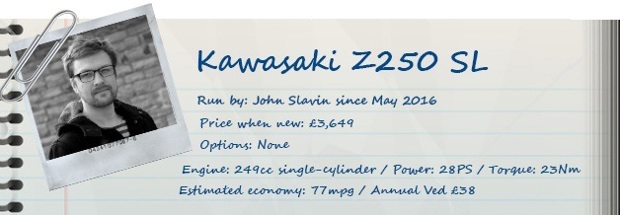Say hello to our little green Kawasaki
For the next few years John will be enjoying the company of a bright green, 250cc Z250SL. This is why he chose it...
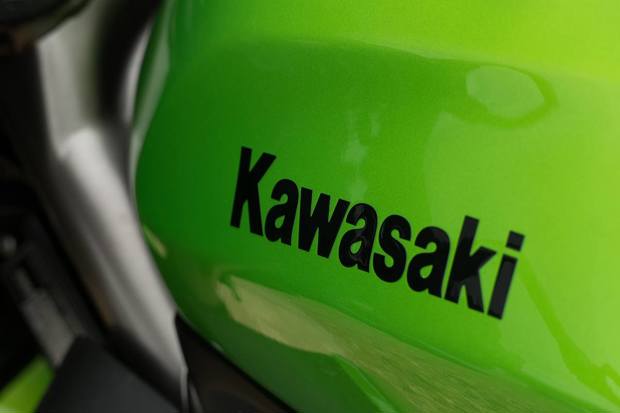
Date: 27 July 2016 | Current mileage: 0 | Costs this month: £0
These days a 250cc motorcycle has limited appeal. The capacity is too large for a learner and, for most A2 or full licence holders, it’s too small to provide enough excitement or flexibility. And yet here I am, introducing my 250cc motorcycle, despite the fact I have a full, unrestricted licence. Maybe I just like Candy Lime Green?
Actually, small, light, cheap motorcycles are my guilty pleasure and the Z250SL fits the bill perfectly. Compared to other A2 licence-friendly machines it’s down on power and torque – but its weight of just 148kg (SL stands for Super Light) is comparable to a Yamaha R125, the sportiest learner-friendly bike on sale.
But it has roughly twice the power and torque of the £4399 R125 and it costs less, at £3649. For me, the Kawasaki is a bit like reliving my teenage years riding an Aprilia RS50, but with enough grunt to make use of motorways and the bonus of a reliable four stroke engine, rather than a screeching two-stroke. And I really do like Candy Lime Green. A lot.
Peak power is a fairly inconsequential 28PS at 9700rpm, with peak torque of 23Nm from 8200rpm. For the first few weeks those numbers are out of reach, however, since until the 600 mile running in service I have to keep the revs down. That is proving difficult, given the way the bike wakes up suddenly at about 6000rpm.

The Z250SL is as light and small as a 125, but with twice the power
Fortunately, 60mph is at around 5000rpm, so keeping up with traffic doesn’t mean upsetting the brand new engine. Being so small and light, the Z250 is extremely easy to ride through corners. The riding position is reasonably comfortable, despite fairly high foot pegs, largely thanks to the sensible handlebars.
Kawasaki also sells a Ninja 250SL, which is broadly the same as the Z250SL but for its full fairing, clip-on handle bars and lower pegs. It only costs £200 more, so if the Z250SL appeals but you want sportier styling it’s a good bet. You'll just have to settle for gloss green instead of metallic. There’s also a KRT version of the Ninja 250SL with World Superbike colours for £3949.
So far the Z250SL has only covered a few miles, but I’ve already decided it needs an aftermarket exhaust, since it makes barely any sound at all. I think, both for ensuring other drivers notice me and for the sake of my own entertainment, motorcycles should be easy to hear and easy to see, so a near silent exhaust is no good.
The Z250SL will be with me for the next few years, so I’ll be giving it a thorough long term test. The first job, before anything else, is getting the running in period out of the way. As is the norm for motorcycles, a first service is due after 600 miles. It’s simple enough, with just an oil change and a once over to ensure things are all in good order.
First service and first problem
The Kawasaki's engine has been liberated by the run-in service - but it hasn't all been plain sailing.

Date: 12 August 2016 | Current mileage: 636 | Costs this month: £109 (First service)
One thing that’s likely to surprise riders when they buy a brand new bike is the run-in service. Like cars, motorcycles need to be treated gently for the first few hundred miles until the engine is worn in. However, unlike cars, bikes need a quick service once that process is complete.
That means taking the bike back to the dealer after just 600 miles, which on my Z250SL took a month or so. Thankfully the first service is cheap at just over £100. It takes roughly an hour and a half and involves changing oil and checking various things like chain adjustment.
The first service went smoothly with the Z250SL, with no anomalies or problems to report. Unfortunately, it’s not a full check over of every single nut and bolt, otherwise an irritating problem might have been avoided a few days after the service, when a screw vibrated loose and caused the clutch to stop working.
The clutch on the Z250SL is very small and consequently very light, meaning it is operated by a simple cable rather than hydraulics. Over time one of the two screws holding in a guide for the metal clutch cable worked loose, which caused the cable to twist, rather than pull – stranding me at the roadside.

Spot the missing bolt
Kawasaki provides RAC membership with its new bikes, so I called for assistance. After 45 minutes at the roadside, by which time I’d grown impatient, they called me again to say they would be another hour, which spurred me on to find an alternative solution, despite the lack of a suitable spanner in the provided tool roll.
Luckily an unessential protective plate at the front of the Z250SL uses a bolt with the same thread and a different head, which the toolkit would fit, so I swapped it over and got underway to the local dealer. Fortunately, that wasn’t a long journey and they sorted everything in a few minutes, free of charge.
It wasn’t the most stressful experience in the world. It was quite easy to see what the problem was even for a mechanical novice and I knew it was a simple, easy fix. But it’s a shame one bolt working loose – as unlikely as that is – can leave a rider stranded by the roadside. Still – that’s how it often goes with bikes.
Aside from that hiccup the Kawasaki has been great. Now it’s been run in and serviced it’s possible to use all of the rev range, which wasn’t possible before. The Kawasaki really comes alive beyond 8000rpm, where peak power and torque are produced. It’s easier to keep up on motorways and get past slow traffic now too.
Bring the noise
John has changed the standard exhaust silencer on the Z250SL to make it a bit more noticeable in traffic.
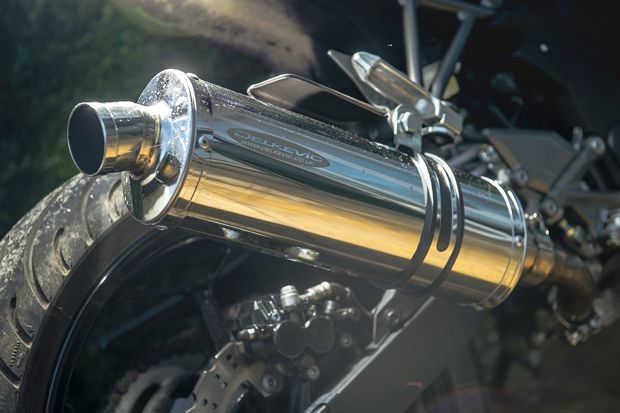
Date: 12 September 2016 | Current mileage: 793 | Costs this month: £120 (Delkevic silencer)
I knew from my very first ride on the Z250SL that it was too quiet. Many people will question the need for a particularly loud bike – they’re obnoxious and antisocial, really – but the Z250 was close to silent, which is bad news in traffic. Other motorists tend to have a tricky time spotting slim, small bikes, so being heard is essential.
Aftermarket exhausts are expensive though – and a bit hard to find for the Z250. Fortunately, they do exist, although they’re more commonly listed for the Ninja 250SL. Fitment is the same for both the Ninja and Zed though, as I discovered when I ordered a Ninja 250SL slip-on from Delkevic.
Based in Stoke-on-Trent, Delkevic produces a range of slip-on exhaust designs to suit most current bikes, many of which meet requirements to be road legal – though some are restricted to track use only. The basic stainless steel oval design I chose for the Z250SL is the cheapest option.
It certainly doesn’t feel cheap though. Construction is really sturdy, with a perfect mirror finish – plus it’s appreciably lighter than the standard silencer, although a pricier carbon fibre option is lighter still. Installation requires basic tools and takes about 15 minutes, so almost anyone can do it at home.
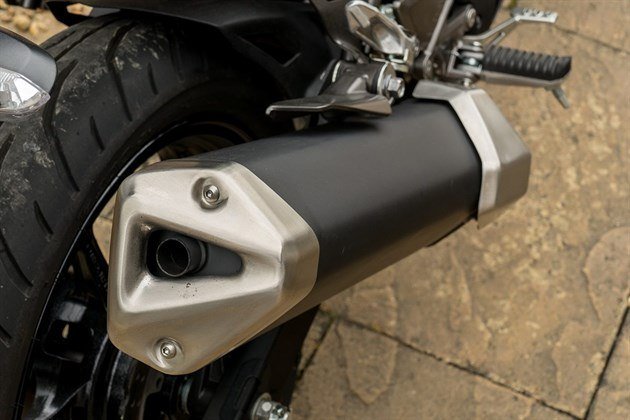
I've kept the original safe for when I come to sell the bike
Once fitted the Delkevic slip-on sounds much better than the standard exhaust. There’s far more bass and a decent amount of extra volume, meaning the Z250 catches people’s attention. It isn’t obnoxious, though – neighbours don’t complain, dogs don’t bark and windows don’t rattle.
Having said that, the baffle can be removed with a single hex bolt – and that makes things very loud indeed. It’s probably not a wise move though, since it’ll attract all of the wrong kind of attention and it probably pushes the level of noise over the legal limit. Nobody wants to get pulled over by a traffic officer.
There’s no obvious change to performance though, despite the slight reduction in weight. A downpipe with no catalyser is available from Arrow, which would probably yield a bit more power but it isn’t approved for road use. And besides, I’m quite happy with the way the Z250SL performs.
That said, the tyres aren’t particularly communicative so I plan to replace those in the future. And, like with the exhaust, there is a limited selection of options since the tyre fitment isn’t particularly common. Fortunately, tyre size is shared with every 17-year-old’s dream bike - the Yamaha R125 - so options are available.
Time to get some better tyres
The original equipment tyres supplied with the Z250SL aren't great, so John's changed them for some Michelin Pilot Streets.

Date: 17 October 2016 | Current mileage: 987 | Costs this month: £150 (tyres and mobile fitting)
After getting used to the Z250SL I only had two minor criticisms. First, the extremely quiet exhaust, which wasn’t ideal for being noticed by distracted motorists on a morning commute. Second, the standard tyres. They are Dunlop TT900s from the factory and, frankly they’re a bit rubbish.
They’re not bad in dry conditions, but they don’t inspire huge amounts of confidence when leaning over into bends because they are hard and don't grip very well. They're even worse in the wet, providing very little feedback at all which, on a bike aimed at new riders or all-weather commuters, isn’t ideal, even considering the budget price.
When driving a car, the level of tyre feedback is neither as obvious nor as important as when riding a bike, since even when skidding a car isn’t going to fall over. On a bike, if one of the tyres lets go it’s definitely bad news – so I decided it would be worth changing to some better rubber.
Unfortunately, getting hold of tyres to fit the Z250SL is quite tricky because it has an unusual front wheel dimensions. Pleasingly, the front and rear fitment is identical to one of the most popular learner 125s on sale – the Yamaha R125. So even if there isn’t a huge amount of tyre choice, there is at least some.
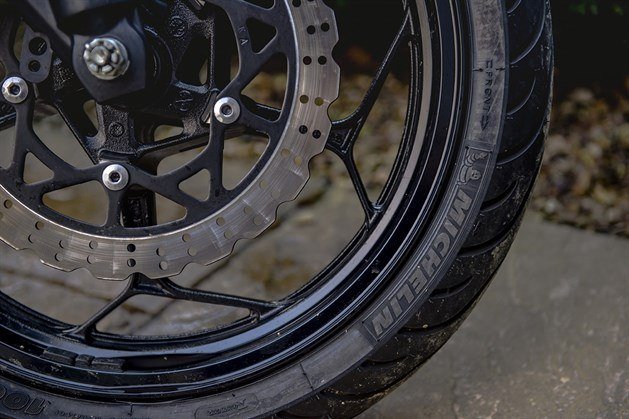
The new tyres provide much better feel and inspire confidence in bends
Michelin produces Pilot Streets in the right size and they get very positive reviews, so I opted for a set of those to replace the Dunlops, despite the original tyres still having loads of tread. In the correct size they cost roughly £100 for both, plus fitting, which was carried out by Mark from mobile-bike-tyres.co.uk.
It took 60 miles to wear the tyres in, which is less than the 100 miles that most manufacturers' recommend. But even before they were worn in properly there were obvious improvements, with a crisper, more precise, confidence-inspiring feel when leaning over into bends.
This improved further once the tyres were scrubbed in properly, plus they provide better feel in rain than the old Dunlops, giving a more secure feel when cornering or braking on wet roads. That’s not a huge concern for me, since I don’t ride all that often in rain but, for many commuters, wet weather performance is very important.
They’re quite obviously better, but for most buyers they’re probably only worth buying if you need to replace your tyres through wear, rather than as an upgrade straight from the showroom – especially on a bike where budget is a key consideration. But if you do want to upgrade I can certainly recommend the Pilot Streets.
Two-up on the Z250SL
Can you carry passengers on the Z250SL or is it strictly a one-up machine?
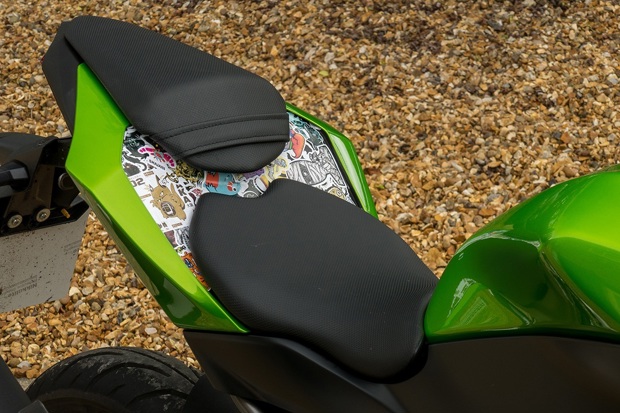
Date: 17 November 2016 | Current mileage: 1085 | Costs this month: £10 (sausage sandwiches for two)
The back seat on the Kawasaki Z250SL isn’t exactly opulent - in fact it’s pretty cruel. There is a sort of flimsy, strappy thing in place of grab rails, the foot pegs are high and the pillion pad itself is sadistically small. But we’re thorough here at Honest John, so I decided to try it out. By making someone else sit on it.
If you’re planning to carry a passenger on a bike then it’s important to have some rear suspension adjustment. Firming up the settings will improve safety, handling and comfort with someone sat on the rear seat so, first things first, I checked the preload adjustment for the rear suspension, which is a bit hard to access.
More importantly, there is no centre stand so you can’t to take the weight off the back wheel on the fly - which makes it close to impossible to change the settings. In the end I gave up, but fortunately my willing passenger was my younger sister – a 16-year-old who weighs about the same as a brick of Shredded Wheat.
With her on board there was essentially no difference in the way the bike felt. There was none of the front-end weave that’s typical when carrying a pillion – but I’d put that down to our combined weight being less than the weight of some people on their own. We have skinny genes (and she has skinny jeans).

The lack of a centre stand means rear suspension adjustment is hard work
My sister isn’t a very experienced pillion, but with a bit of tuition she quickly relaxed and made our ride very easy. It was short, but enough for both of us to get a feel for the little Kawasaki two-up. And it’s fair to say it isn’t all that bad, considering how uncomfortable it looks at first glance.
It’s hardly easy to recommend if you’re planning to carry passengers regularly or far, of course. Wind noise, the lack of secure grab handles and the uncomfortably thin pillion pad mean anything more than an 30 minutes is painful for a passenger, and the bike probably wouldn’t cope well with anyone heavy or tall perched up there.
But for a short, occasional trip it’s okay. Handling isn’t really affected much with a light passenger on board and the brakes perform well enough to keep things under control, although maintaining a smooth ride requires a little more forethought and delicacy, just like it would on any other bike.
So, if you absolutely have to give someone a lift on the back of a Kawasaki Z250SL you can. But unless they enjoy pain and discomfort, they won’t like it – and the bike won’t thank you for it much either. But you probably aren’t considering a Z250SL for a two-up tour of the Pyrenees anyway…
Winter riding
John's decided, with a very significant amount of reluctance, to ride around in the winter weather, just to see how the Z250SL copes.
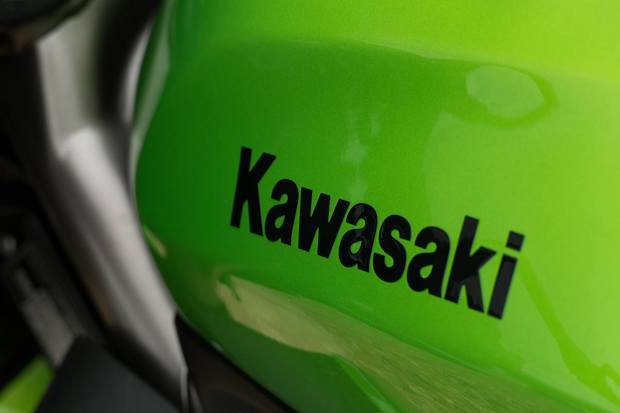
Date: 17 December 2016 | Current mileage: 1363 | Costs this month: £3 (indicator bulb)
The cold, horribleness of winter has finally arrived. And I’ve decided, with a very significant amount of reluctance, to ride around in it a bit, just to see how the Z250SL copes. Fortunately, I have some half decent gear to keep myself dry and warm, so this is less a test of my own capabilities than those of the bike.
I’m especially pleased I decided to fit the Michelin Pilot Street tyres now the weather has taken a turn or the worse, since they maintain a surprising level of softness even at very low temperatures – meaning decent grip on cold tarmac. Performance isn’t bad in the wet either, but some more weather protection would be handy.
The little fairings on the tank do pretty much nothing to keep the cold away from my knees, while the lack of a screen means road dirt and salt kicked up by traffic ahead quickly make a mess of the visor on my helmet. I also get cold hands, since there is nothing to deflect the wind away from my knuckles.
All things considered, I’d rather be on a big, warm tourer in this weather. But, had I bought this bike to commute I’m sure it would stand the test of a British winter quite well. The green paint is still gleaming, the frame still shines and nothing is showing the faintest hint of corrosion. For a budget bike that lives outside 24/7 I’m impressed.

The light is OK - but it's not exactly powerful
Not only is winter cold, it’s dark – so a decent headlight is handy. The light on the Z250SL isn’t bad, but it’s hard to call it anything more than adequate. On main beam it provides enough light to make sense of a familiar road, but for unfamiliar places it’d be nice to have a bit more power.
It’s fine in town though and it’s bright enough to be noticed by other motorists, so for commuters it’s up to the job. On the topic of lights, one of the indicators bulbs failed recently on a long ride, causing the rest of the indicator lights to stay on instead of blink. Changing the bulb is easy though so it wasn’t a huge problem.
And that’s not the only issue I’ve had in the winter – the digital instruments have been playing up a little. Everything is still easy to read, but occasionally some of the sections of the display become very faintly visible when they shouldn’t, a bit like when you press the screen a calculator.
Hopefully that problem will pass when Spring finally arrives. And hopefully the bike will get a bit more use then too, because at the moment I tend to look out of the window, see the sky and think to myself “I’ll just use the car today”. Bring on the sun!


